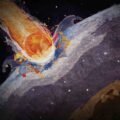Unidentified aerial phenomena (UAP) appearing to exhibit “highly maneuverable” capabilities should produce luminosity and other observable features, including radio frequency signatures, according to calculations presented in a new study that calls for the better application of known physics in efforts to evaluate the phenomena.
The paper was co-authored by Avi Loeb, Harvard University astronomer and head of the Galileo Project, and Dr. Sean Kirkpatrick, director of the All-domain Anomaly Resolution Office, the office currently leading the Pentagon’s efforts to study unidentified objects detected in U.S. airspace.
“We derive physical constraints on interpretations of ‘highly maneuverable’ Unidentified Aerial Phenomena (UAP) based on standard physics and known forms of matter and radiation,” Loeb and Kirkpatrick state in the paper’s abstract.
“In particular, we show that the friction of UAP with the surrounding air or water is expected to generate a bright optical fireball, ionization shell and tail – implying radio signatures,” the paper’s authors write.
In an interview, Loeb told The Debrief that the collaboration was the product of an initial conversation with Kirkpatrick, who wrote to the astronomer asking if they could meet while he was visiting near Harvard.
“He said he was visiting in the area where I live, and asked if he could meet with me,” Loeb said. “He came, sat in my living room, and we discussed the subject.”
Although Kirkpatrick is privy to classified information the U.S. intelligence community collects on unidentified aerial objects, Loeb told The Debrief that he and the Galileo Project have not had access to such information, nor was it referenced for the work he and Kirkpatrick presented in their paper.


“I didn’t sign any NDA,” Loeb said. “I had no exposure to classified information. And [Kirkpatrick] knows that.”
“So he said, well, it would be a good idea to write a scientific paper that sort of sets the boundaries based on the physics we know. If there is incomplete data from instruments, what can we say about the distances [and] the speeds of objects?”
According to a 2021 preliminary assessment of data collected by the U.S. intelligence community about UAP, a small number of objects observed by military personnel reportedly demonstrated acceleration, signature management, or other capabilities that could not easily be explained in the context of known technologies.
“Although most of the UAP described in our dataset probably remain unidentified due to limited data or challenges to collection processing or analysis,” the 2021 report said, “we may require additional scientific knowledge to successfully collect on, analyze and characterize some of them.”
A second report published by the Office of the Director of National Intelligence earlier this year based on work by Dr. Kirkpatrick’s office, while appearing to place less emphasis on such incidents, nonetheless conveyed that some UAPs “appear to have demonstrated unusual flight characteristics or performance capabilities, and require further analysis.”
While additional analysis, and perhaps even further scientific advancements may be required to characterize and fully understand some UAP, Loeb says that this does not necessarily mean that it also requires the discovery of new physics, an assumption that often accompanies interpretations of the phenomena.
“Physicists have been struggling for five decades to find evidence of new physics,” Loeb said.


“We have to respect the laws of physics as we know them,” Loeb told The Debrief. “We can’t just say forget about it, whatever my imagination allows me is possible. That’s not a valid approach.”
“The burden of proof is on you,” Loeb says. You can’t just say it’s new physics because [you] have incomplete data.”
“You have to demonstrate that this object is moving in ways that we cannot explain using known physics. And then you might be able to consider new physics.”
Loeb says that in their recent paper, he and Dr. Kirpatrick worked to establish characteristics that would be associated with highly maneuverable instances of UAP based on known physics.
LISTEN: Avi Loeb discusses “Physical Constraints on UAP” on The Micah Hanks Program
One of the primary sources for data on UAP from military sources involves footage of unknown objects captured using technologies like Raytheon’s AN/ASQ-228 Advanced Targeting Forward-Looking Infrared (ATFLIR), an electro-optical targeting pod that relies on multi-sensor capabilities to target and track fast-moving objects.
“These sensors provide an accurate resolved image of relative thermal measurements across the scene,” Loeb and Kirkpatrick write in their paper, although they note that most UAP observations occur at ranges too distant to produce highly-resolved images of these objects, which places significant limitations on the accuracy of measurements regarding their motion and speed, mostly due to insufficient range data.
“The range is usually estimated using the flight dynamics of the platform and some fixed points in the scene,” the authors note. However, when errors occur in estimating the range of objects in such instances, the result can be that the velocities attributed to the objects can be greatly overestimated.
In their paper, Loeb and Kirkpatrick argue that calculations resulting in objects exceeding transonic and supersonic ranges should be checked against the known physics of phenomena that include ionization, which dictates that luminosity would be present around objects moving at such speeds through Earth’s atmosphere. Similar reliance on the known physics of temperature, sound (i.e. sonic booms produced by fast-moving objects), radar reflectivity, and other phenomena should be given equal consideration, all of which, the authors say, “can more effectively and accurately bound the velocity, and hence drive the range calculation.”
“This will, in turn, when matched with the specifics of the sensor, allow for better estimates of the size, shape, and mass of the object in question,” they write.
Fundamentally, Loeb says that whether it involves the work by civilian scientific groups like the Galileo Project, or the DoD’s efforts under Dr. Kirkpatrick with AARO, reliance on known physics should drive evaluations of UAP that appear to demonstrate high maneuverability or other advanced capabilities.
“The burden of proof is on those who claim new physics,” Loeb told The Debrief. “That is a fundamental facet of the way we do science.”
“You can’t just imagine things like Stephen Spielberg imagines in his Hollywood scripts,” he adds. “That’s science fiction.”
“The difference between science fiction and science is evidence.”
Micah Hanks is the Editor-in-Chief and Co-Founder of The Debrief. He can be reached by email at micah@thedebrief.org. Follow his work at micahhanks.com and on Twitter: @MicahHanks.

